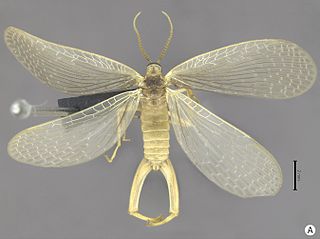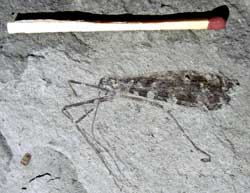
Flea, the common name for the order Siphonaptera, includes 2,500 species of small flightless insects that survive as external parasites of mammals and birds. Fleas live by consuming blood, or hematophagy, from their hosts. Adult fleas grow to about 3 millimetres long, are usually brown, and have bodies that are "flattened" sideways or narrow, enabling them to move through their host's fur or feathers. They lack wings, but have strong claws preventing them from being dislodged, mouthparts adapted for piercing skin and sucking blood, and hind legs extremely well adapted for jumping. They are able to leap a distance of some 50 times their body length, a feat second only to jumps made by another group of insects, the superfamily of froghoppers. Flea larvae are worm-like with no limbs; they have chewing mouthparts and feed on organic debris left on their host's skin.

Mecoptera are an order of insects in the superorder Endopterygota with about six hundred species in nine families worldwide. Mecopterans are sometimes called scorpionflies after their largest family, Panorpidae, in which the males have enlarged genitals that look similar to the stingers of scorpions, and long beaklike rostra. The Bittacidae, or hangingflies, are another prominent family and are known for their elaborate mating rituals, in which females choose mates based on the quality of gift prey offered to them by the males. A smaller group is the snow scorpionflies, family Boreidae, adults of which are sometimes seen walking on snowfields. In contrast, the majority of species in the order inhabit moist environments in tropical locations.
Frank Morton Carpenter received his PhD from Harvard University, and was curator of fossil insects at the Harvard Museum of Comparative Zoology for 60 years. He studied the Permian fossil insects of Elmo, Kansas, and compared the North American fossil insect fauna with Paleozoic taxa known from elsewhere in the world. A careful and methodical worker, he used venation and mouthparts to determine the relationships of fossil taxa, and was author of the Treatise volume on Insects. He reduced the number of extinct insect orders then described from about fifty to nine.

Meropeidae is a family of tiny scorpionflies within the order Mecoptera with only three living species, commonly referred to as "earwigflies". These include the North American Merope tuber, the Western Australian Austromerope poultoni, and the recently discovered South American A. brasiliensis. The biology of these species is essentially unknown, and their larvae have never been seen. The disjunct distribution suggests a common origin before the breakup of the ancient supercontinent of Pangaea. There are two undisputed extinct genera, Boreomerope antiqua known from an isolated wing found in the Middle Jurassic Itat Formation of Siberia and Burmomerope with three species from the Cenomanian aged Burmese amber. As such, the extant members of this family can be considered living fossils. These insects are also of interest due to their presumed basal position in the order Mecoptera. Thaumatomerope with four described species all from the Madygen Formation in Kyrgyzstan has historically sometimes been included within the family, it was placed into its own monotypic family, "Thaumatomeropidae." in 2002.
Nannochoristidae is a family of scorpionflies with many unusual traits. It is a tiny, relict family of about eight species, with members of the genus Nannochorista occurring in New Zealand, southeastern Australia, Tasmania, and Chile, so is probably of Gondwanan origin. The adults look like scorpionflies with more pointed, elongated wings. Most mecopteran larvae are eruciform, or shaped like caterpillars. Nannochoristid larvae, however, are elateriform, or shaped like wireworm or click beetle larvae. They are also the only entirely aquatic Mecoptera. Wing venation suggests a close relationship to dipterans. They are predatory, primarily on the larvae of aquatic Diptera.

Bittacidae is a family of scorpionflies commonly called hangingflies or hanging scorpionflies.

Boreidae, commonly called snow scorpionflies, or in the British Isles, snow fleas are a very small family of scorpionflies, containing only around 30 species, all of which are boreal or high-altitude species in the Northern Hemisphere. Recent research indicates the boreids might be more closely related to fleas than to other scorpionflies, which would render the order Mecoptera paraphyletic if the order Siphonaptera is excluded from it.

The Panorpidae are a family of scorpionflies containing more than 480 species. The family is the largest family in Mecoptera, covering approximately 70% species of the order. Species range between 9–25 mm long.

Eomeropidae is a family of aberrant, flattened scorpionflies represented today by only a single living species, Notiothauma reedi, known from the Nothofagus forests in southern Chile, while all other recognized genera in the family are known only as fossils, with the earliest definitive fossil known from Liassic-aged strata, and the youngest from Paleogene-aged strata.

The Haifanggou Formation is a fossil-bearing rock deposit located near Daohugou village of Ningcheng County, in Inner Mongolia, northeastern China.

Cimbrophlebia is an extinct genus of Mecoptera which existed from the Jurassic to the Eocene period.
Mongolbittacus is an extinct genus of hangingfly in the family Bittacidae and containing a single species Mongolbittacus daohugoensis. The species is known only from the Middle Jurassic Jiulongshan Formation, part of the Daohugou Beds, near the village of Daohugou in Ningcheng County, northeastern China.
Formosibittacus is an extinct genus of hangingfly in the family Bittacidae and containing a single species Formosibittacus macularis. The species is known only from the Middle Jurassic Jiulongshan Formation, part of the Daohugou Beds, near the village of Daohugou in Ningcheng County, northeastern China.
Jurahylobittacus is an extinct genus of hangingfly in the family Bittacidae and containing a single species Jurahylobittacus astictus. The species is known only from the Middle Jurassic Jiulongshan Formation, part of the Daohugou Beds, near the village of Daohugou in Ningcheng County, northeastern China.

Bittacus is a genus of hangingflies in the order Mecoptera. Members of the genus have a cosmopolitan distribution. The genus has existed since at least the earliest Late Cretaceous. Bittacus is considered "grossly paraphyletic" and serves as a catch-all for many distantly related species of hangingflies.

Hylobittacus apicalis is a species of hangingfly in the order Mecoptera, and the only species within the genus Hylobittacus.

Panorpida or Mecopterida is a proposed superorder of Endopterygota. The conjectured monophyly of the Panorpida is historically based on morphological evidence, namely the reduction or loss of the ovipositor and several internal characteristics, including a muscle connecting a pleuron and the first axillary sclerite at the base of the wing, various features of the larval maxilla and labium, and basal fusion of CuP and A1 veins in the hind wings. The monophyly of the Panorpida is supported by recent molecular data.

Fortiholcorpa paradoxa is an extinct species of scorpionfly (Mecoptera) from the Middle Jurassic of China. It is the only known species of its genus.

Jurassipanorpa is a genus of fossil scorpionfly containing two species described in 2014 from the Jiulongshan Formation of Inner Mongolia, China. The two species, J. impuctata and J. sticta, lived in the late Middle Jurassic period and represent the oldest known representatives of the scorpionfly family Panorpidae.
Holcorpa is a genus of extinct insects in the scorpionfly order Mecoptera. Two Eocene age species found in Western North America were placed into the genus, H. dillhoffi and H. maculosa.












